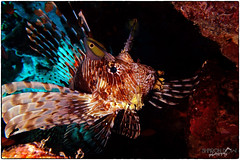Common Lionfish (Pterois Miles)
Sharon Dow Photography posted a photo:
Pterois miles, commonly known as the common lionfish or devil firefish, is a species of ray-finned fish. It is native to the western Indo-Pacific region and is frequently confused with its close relative, the red lionfish (Pterois volitans). The scientific name is from Greek "pteron", wing, and Latin "miles", soldier.
The common lionfish grows up to 35 cm (14 in) in length. The dorsal fin has thirteen long, strong spines and nine to eleven soft rays and the anal fin has three long spines and six to seven soft rays. The dorsal fin appears feathery and the pectoral fins are wing-like with separate broad, smooth rays. This fish varies in colour from reddish to tan or grey and has numerous thin dark vertical bars on its head and body. Its head is less angular than that of P. volitans.
The common lionfish is mainly nocturnal and may hide in crevices during the daytime. It feeds on fish and small crustaceans. It has few predators, probably because of its venomous spines, but larger lionfish do prey on smaller ones. It has been shown that the bluespotted cornetfish (Fistularia commersonii) feeds on it, as also do groupers in the Bahamas.
P. miles is native to the Indian Ocean, from the Red Sea, to South Africa, and to Indonesia; it is also known in the eastern Mediterranean Sea. It is very similar in appearance to P. volitans, which does not occur in the Red Sea, and it has recently been reported in the South Eastern Mediterranean sea, near Cyprus. Because of the current elections at the island, it has been dubbed the "tasaki" (ashtray) fish. This fish is usually found in areas with crevices or lagoons, often on the outer slopes of coral reefs. It is also now present on the east coast of the United States and in the Caribbean Sea where is regarded as an invasive species.
The fin spines are highly venomous and have caused death to humans.
Photographed on the dive site Lagoona in the straits of Tiran, near Sharm el Sheikh, Egypt


Add new comment